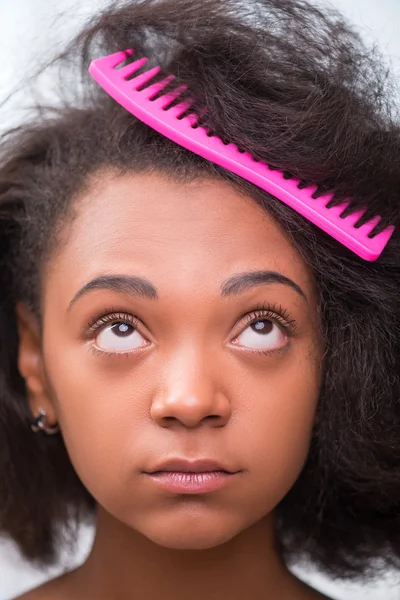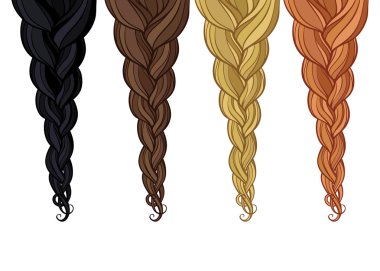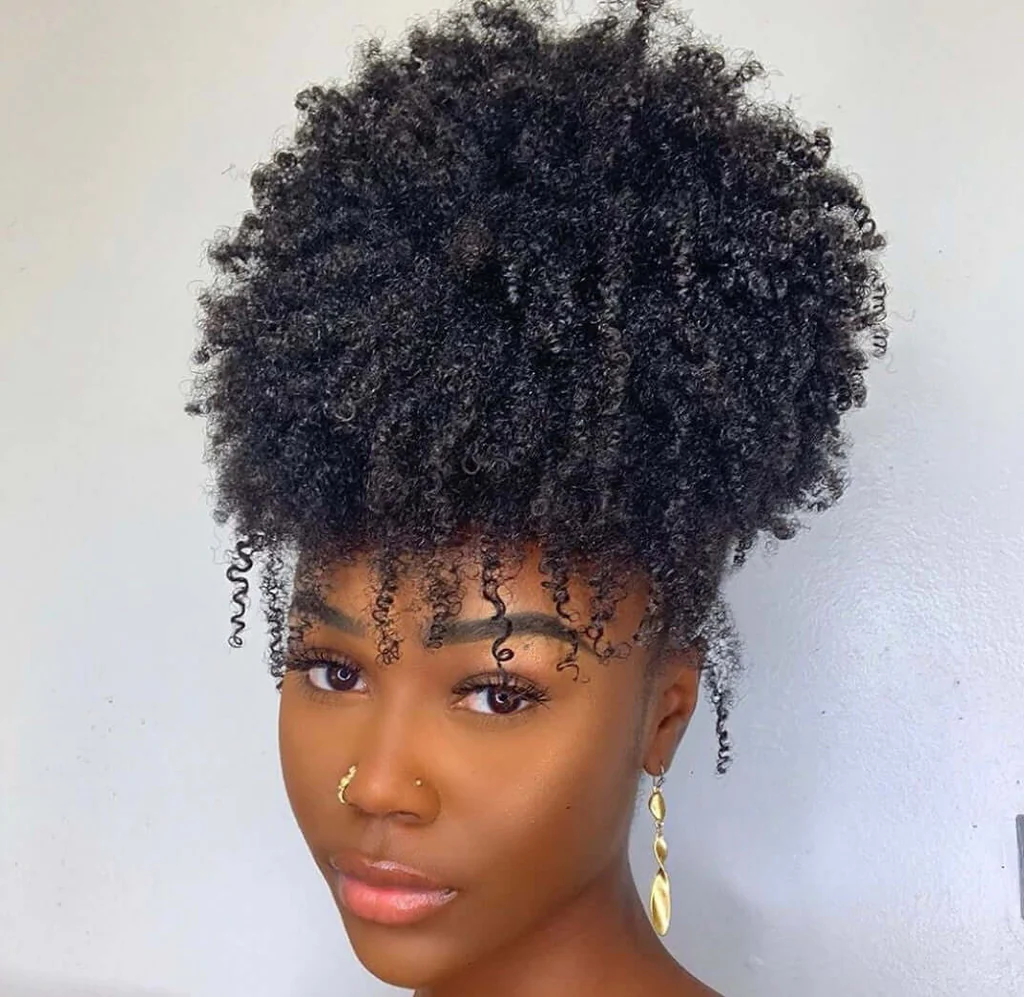The Ultimate Guide To 4C Nighttime Routine

How To Sleep With 4C Hair
Sleeping can be a challenge when you have 4C hair. The beautiful coils and tight curls that make your hair unique can also make it prone to tangles, breakage, and frizz while you sleep.
But fear not! With the right techniques and products, you can wake up with gorgeous, defined curls every morning. In this blog post, we’ll walk you through step by step how to sleep with 4C hair to minimize damage and keep your curls looking their best.
From satin pillowcases to protective styles, we’ve got all the tips and tricks you need. So grab your favorite hair tie and get ready for a good night’s sleep without sacrificing your hair game!
Why Your Nighttime Routine Matters for Healthy 4C Hair
Maintaining healthy 4C hair goes beyond the products and styles you use during the day—it extends into the night with a carefully crafted 4C hair night routine. Here’s why your nighttime routine matters for the health and vibrancy of your 4C curls:
1. Preventing Breakage:
- 4C hair is prone to tangling, and tossing and turning during sleep can lead to breakage.
- A dedicated nighttime routine minimizes the risk of breakage by addressing tangles and knots gently.
2. Retaining Moisture:
- 4C hair tends to be on the drier side, making moisture retention crucial for health and manageability.
- A well-designed nighttime routine focuses on moisturizing techniques to keep your curls hydrated throughout the night.
3. Curl Definition:
- The night offers an opportunity to set your curls in a way that enhances their natural definition.
- Proper techniques, such as twisting or protective styling, contribute to maintaining and enhancing your unique curl pattern.
4. Style Preservation:
- Styles achieved during the day, such as twists or braids, can be preserved overnight.
- This not only saves time in the morning but also helps maintain the longevity of your chosen styles.
5. Overall Hair Health:
- Consistency in nighttime care contributes to the overall health of your 4C hair.
- It establishes a routine that addresses specific needs, creating a foundation for healthy growth and appearance.
6. Morning Manageability:
- A well-maintained nighttime routine makes your hair more manageable in the morning.
- This translates to easier styling, reduced detangling time, and a smoother start to your day.
7. Preventing Knots and Matting:
- 4C hair is susceptible to knots and matting, especially when left unattended overnight.
- A thoughtful nighttime routine involves detangling and protective measures to prevent these issues.

4C Hair Night Routine
Ensuring your 4C hair stays moisturized can be a challenge, especially when you hit the pillow. To tackle this, it’s crucial to hydrate your hair before bedtime.
Simply mix water and leave-in conditioner in a spray bottle, give your hair a good misting from roots to ends, and you’re set.
Applying leave-in conditioner not only locks in moisture but adding a natural oil like coconut oil takes it up a notch, preventing moisture loss and keeping your hair super hydrated as you catch those Z’s. Easy, right?

How To Sleep With 4C Hair
1. Deep Moisturization
Deep moisturization is a game-changer for 4C hair, and understanding its importance is key to maintaining healthy, vibrant curls. The unique texture of 4C hair makes it prone to dryness, as the natural oils produced by the scalp struggle to travel along the tight curls. This makes deep moisturization essential as it penetrates the hair shaft, providing nourishment from within.
Due to the coiled structure of 4C hair, moisture tends to get trapped in the bends and curves, making it more challenging for external moisture to reach the hair’s core.

Deep moisturization techniques, such as using rich and hydrating products like deep conditioners and hair masks, play a crucial role in addressing this challenge, you can also opt for a simple moisturizing agent like water to hydrate your coils. These treatments can penetrate the hair cuticle, ensuring that each strand receives the moisture it needs to thrive.
Moreover, 4C hair is more susceptible to breakage and tangling, and proper moisturization helps to reduce friction between strands, minimizing breakage during manipulation or combing. It also enhances the hair’s elasticity, promoting overall strength and resilience.
2. Gentle Nightly Detangling
Gentle detangling at night is a crucial step in caring for 4C hair, and employing the right techniques is essential to prevent breakage and maintain the health of your curls.
Before detangling, applying a leave-in conditioner, water or a detangling spray can work wonders. This helps to add slip to your hair, making it easier to glide through knots without causing unnecessary tension.

Additionally, consider sectioning your hair into smaller, more manageable parts. This not only ensures a thorough detangling process but also minimizes the risk of causing breakage by attempting to detangle large portions at once.
To start, use a wide-tooth comb or, even better, your fingers to carefully work through knots and tangles. Begin detangling from the tips of your hair, gradually moving upward toward the roots, to minimize stress on the strands.
Take your time and be patient—rushing through the process can lead to hair breakage. If you encounter stubborn knots, gently work on them with your fingers before introducing the comb.
By approaching detangling with care and using the right tools and products, you can effectively prevent breakage and keep your 4C hair in optimal condition, promoting a healthier and more manageable mane.
3. Embracing Protective Styles at Night
Embracing protective styling for your 4C hair during sleep offers a myriad of benefits that not only promote the overall health of your hair but also contribute to maintaining a stylish appearance.
First and foremost, protective styles, such as braids, twists, or buns, help minimize friction between individual strands and against your pillowcase. This reduction in friction translates to less breakage and tangling, preserving the integrity of your 4C curls.

Beyond breakage prevention, protective styling serves as a shield against environmental factors that can lead to dryness. By securing your hair in a protective style, you limit exposure to elements that may strip moisture, ensuring that your curls retain essential hydration overnight. This is particularly beneficial for 4C hair, which is naturally more prone to dryness.
Moreover, incorporating protective styles into your nighttime routine allows for easier morning maintenance. You wake up with a defined and tangle-free style, cutting down the time spent on detangling and styling in the morning. This not only supports the health of your hair but also adds convenience to your daily routine.
In terms of style versatility, protective styles offer an array of options, allowing you to experiment with different looks while safeguarding your hair. Whether you opt for twists, braids, or a stylish updo, protective styling during sleep enables you to showcase your creativity without compromising the health of your 4C hair.
4. Keeping Your 4C Hair Protected Without Twisting
The pineapple technique serves as a fantastic alternative for individuals with 4C hair who prefer not to twist their hair at night but still desire a protective and convenient nighttime routine.
Essentially, the pineapple technique involves loosely gathering your hair at the crown of your head, resembling the shape of a pineapple, and securing it with a satin scrunchie or hairband. This method allows you to protect your curls without the need for intricate twisting.

The key advantage of the pineapple technique lies in its simplicity. It takes mere seconds to gather your hair into a loose, high ponytail, making it an ideal choice for those who seek a quick and effortless nighttime routine. This approach is particularly beneficial for individuals who prefer to minimize manipulation of their hair, avoiding the time-consuming process of twisting.
Additionally, the pineapple technique preserves your curl pattern. By keeping the ends of your hair protected and elevated, you reduce the risk of friction against your pillowcase, minimizing tangling and breakage. This is especially advantageous for 4C hair, which can be more prone to tangling and dryness.
To enhance the effectiveness of the pineapple technique, consider using a satin or silk scrunchie. These materials are gentler on the hair and help prevent friction, promoting healthier and more vibrant curls.
Whether you’re a fan of quick and easy routines or simply prefer a no-fuss approach to nighttime hair care, the pineapple technique offers a protective solution that complements the unique needs of 4C hair.
5. Choosing the Right Sleep Gear for 4C Hair
Using silk bonnets, pillowcases, or scarves is a crucial practice for maintaining the health and style of 4C hair during sleep. The unique texture of 4C hair makes it more susceptible to dryness and breakage, and incorporating silk into your sleep routine provides numerous benefits:
1. Minimizing Friction:
- Silk is smooth and lacks the rough texture of cotton, reducing friction against 4C hair.
- This minimizes tangling and breakage, preserving the integrity of the curl pattern and promoting overall hair health.
2. Retaining Moisture:
- Silk has natural moisture-retaining properties, helping to prevent the excessive absorption of moisture from the hair.
- This is particularly important for 4C hair, which tends to be drier, as it helps maintain optimal hydration levels overnight.
3. Preserving Style:
- Silk bonnets, pillowcases, or scarves help maintain hairstyles by preventing them from becoming flattened or distorted during sleep.
- This is especially beneficial for intricate styles like twists, braids, or curls, allowing you to wake up with your hairstyle intact.
4. Reducing Frizz:
- Silk’s smooth surface reduces friction, which, in turn, minimizes frizz and helps keep the hair cuticle smooth.
- This contributes to a neater and more polished appearance when you wake up in the morning.
5. Temperature Regulation:
- Silk has temperature-regulating properties, keeping the hair cooler in warmer months and warmer in cooler months.
- This prevents excessive drying or sweating that can occur with other materials, maintaining a more balanced and comfortable environment for your 4C hair.
6. Gentle on Hair Strands:
- Silk is gentle on the hair strands, reducing the risk of breakage and damage caused by rougher materials.
- This is especially important for 4C hair, which may be more prone to breakage due to its tighter curl pattern.
Night Routine for Short 4C Natural Hair

Maintaining a healthy night routine for short 4C natural hair is essential to preserve your curl pattern and promote overall hair health. Follow these detailed steps to ensure your short curls stay moisturized, defined, and vibrant:
1. Gentle Detangling:
- Begin by gently detangling your short 4C hair using your fingers or a wide-tooth comb.
- Work from the tips towards the roots, unraveling any knots with care to minimize breakage.
2. Moisturizing Ritual:
- Apply a lightweight leave-in conditioner or a water-based moisturizer to damp hair.
- Focus on even distribution, paying attention to the ends where moisture tends to be most needed.
3. Sectioning:
- Divide your short hair into manageable sections to ensure thorough product application and detangling.
- This step is especially helpful for short hair, allowing you to give attention to every strand.
4. Protective Styling:
- Consider protective styling options like mini twists or braids for short 4C hair.
- These styles protect your curls, minimize tangling, and provide definition as your hair dries.
5. Silk or Satin Accessories:
- Use a silk or satin scarf, bonnet, or pillowcase to reduce friction during sleep.
- These accessories help maintain moisture, prevent breakage, and keep your curls in shape.
6. Scalp Care:
- Massage your scalp gently to stimulate blood flow and promote a healthy environment for hair growth.
- Apply a lightweight scalp oil, such as jojoba or grapeseed oil, if needed.
7. Avoid Tight Styles:
- Opt for loose or low-tension styles to avoid unnecessary stress on short 4C hair.
- Tight styles can lead to breakage, especially for those with shorter lengths.
8. Nighttime Refresh:
- In the morning, assess your hair and refresh your curls if necessary.
- Use a water and leave-in conditioner mixture to revitalize your curls.
9. Trimming Routine:
- If needed, incorporate a regular trimming routine for short 4C hair.
- Trimming helps maintain shape, removes split ends, and supports healthy hair growth.
10. Minimal Heat Usage:
- Embrace air-drying as much as possible to minimize heat damage.
- If heat is necessary, use low-heat settings and a heat protectant.
11. Consistency is Key:
- Establish a consistent nightly routine that works for your short 4C natural hair.
- Consistency fosters healthy habits and ensures your curls receive regular care.
12. Celebrating Your Texture:
- Embrace and celebrate the natural texture of your short 4C hair.
- Experiment with styles that accentuate your curls, showcasing the beauty of your unique hair.
By incorporating these detailed steps into your night routine, you’ll nurture and showcase the beauty of your short 4C natural hair. Adjust the routine based on your specific needs and preferences, and enjoy waking up to well-moisturized, defined, and healthy curls every morning.
How to Sleep with Wet 4C Hair
Sleeping with wet 4C hair requires careful consideration to ensure you wake up with well-defined curls and minimal frizz. Follow these steps for a healthy and stylish nighttime routine:
1. Preparation:
- Start by detangling your wet hair gently with a wide-tooth comb or your fingers.
- Apply a leave-in conditioner or a moisturizing product to enhance hydration.
2. Microfiber Towel or T-shirt Drying:
- Use a microfiber towel or a soft cotton T-shirt to blot excess water from your hair.
- Avoid rough towels that can cause frizz and disrupt your curl pattern.
3. Section Your Hair:
- Divide your hair into manageable sections. This makes it easier to apply products evenly and prevents tangling.
4. Apply Styling Products:
- Use a styling product that suits your hair, such as a curl cream or defining gel.
- Apply the product to each section, ensuring even coverage from roots to ends.
5. Pineapple Technique:
- Gather your damp hair at the top of your head, forming a loose ponytail that resembles a pineapple.
- Secure it with a silk or satin scrunchie to prevent breakage and maintain the curl pattern.
6. Silk or Satin Pillowcase:
- Invest in a silk or satin pillowcase to reduce friction and avoid absorbing moisture from your hair.
- These materials promote a smooth surface that helps protect your curls.
7. Protective Bonnet or Scarf:
- Alternatively, consider wearing a silk or satin bonnet or wrapping your hair in a silk scarf for added protection.
- This shields your curls from friction and helps preserve the style.
8. Avoid Tight Styles:
- Ensure that any securing accessories, like scrunchies or hair ties, are not too tight.
- Tight styles can cause stress on wet hair, leading to breakage.
9. Morning Refresh:
- In the morning, assess your hair and refresh as needed.
- Apply a light mist of water or a water and leave-in conditioner mixture to revive your curls.
10. Avoid Heat Styling:
- While your hair is wet, avoid using heat-styling tools.
- Embrace your natural texture and allow your curls to air-dry or dry with minimal heat.
11. Protective Styles for Wet Hair:
- Consider protective styles like braids or twists for wet hair.
- This not only protects your curls but also provides a defined look when you wake up.
12. Consistent Nightly Routine:
- Establish a consistent routine for sleeping with wet 4C hair.
- Experiment with various techniques to find what works best for your unique curl pattern and preferences.
By incorporating these steps into your routine, you can confidently sleep with wet 4C hair, ensuring that your curls stay hydrated, defined, and free from excessive frizz. Adjust the process based on your hair’s specific needs and experiment with different products to discover the perfect nighttime routine for your beautiful curls.
Is It Bad To Sleep With Wet 4C Hair?
Yes, it is!
Sleeping with wet 4C hair can potentially lead to issues such as breakage and increased vulnerability to damage. Wet hair is more prone to friction and tangling, especially when rubbed against pillowcases or bedding during sleep.
The prolonged dampness may also make the hair shaft more susceptible to stretching and breakage. Additionally, the absence of proper drying time overnight can create a damp environment, potentially fostering conditions conducive to mildew or fungal growth on the scalp.
To maintain the health of 4C hair, it is generally advisable to allow the hair to air-dry or use a low-heat setting before bedtime to minimize the risk of damage and ensure the curls remain well-defined and hydrated.
How Do You Keep 4C Hair Detangled Overnight?
Begin by gently detangling damp hair using a wide-tooth comb or your fingers, focusing on smaller sections for thorough care.
Apply a leave-in conditioner or a detangling spray to add slip and facilitate smoother detangling. To protect your curls, consider using the pineapple technique, gathering your hair into a loose, high ponytail secured with a silk or satin scrunchie.
Alternatively, opt for a silk or satin bonnet, scarf, or pillowcase to minimize friction during sleep. Regular moisturization and consistent nightly routines contribute to overall hair health, making detangling more manageable each morning.
General Healthy Nighttime Rituals for 4C Curls
- Gentle Detangling:
- Use a wide-tooth comb or fingers to gently detangle 4C hair.
- Start from the tips and work your way up to the roots to minimize breakage.
- Moisturize Thoroughly:
- Apply a leave-in conditioner or a water-based moisturizer to hydrate 4C hair.
- Focus on the ends and areas prone to dryness.
- Protective Styling:
- Choose a protective style like twists, braids, or a loose bun to minimize friction.
- Protecting the ends of the hair is especially important for 4C curls.
- Use Silk or Satin Accessories:
- Invest in a silk or satin bonnet, pillowcase, or scarf.
- These materials reduce friction, help retain moisture, and preserve styles.
- Scalp Care:
- Massage the scalp gently to stimulate blood circulation.
- Apply a lightweight oil, such as jojoba or grapeseed oil, to nourish the scalp.
- Secure Styles:
- If you have a styled look, use silk or satin accessories to secure the style.
- This helps maintain the integrity of the hairstyle overnight.
- Avoid Tight Styles:
- Refrain from styles that pull on the hair tightly, as this can lead to breakage.
- Opt for looser styles that provide protection without causing stress.
- Silk Pillowcases and Bedding:
- Consider investing in silk or satin pillowcases and bedding.
- This reduces friction and helps maintain the health of 4C hair during sleep.
- Hydrate from Inside Out:
- Stay hydrated by drinking enough water throughout the day.
- Hydration supports overall hair health and helps prevent dryness.
- Protective Bonnet or Scarf for Loose Styles:
- If you prefer to wear your hair loose, use a protective bonnet or scarf to shield your curls during sleep.
- This prevents tangling and maintains moisture.
- Consistent Nighttime Routine:
- Establish a consistent nighttime routine that suits your hair needs.
- Consistency is key to seeing long-term improvements in the health and appearance of 4C curls.
By incorporating these healthy nighttime rituals into your routine, you can nurture and protect your 4C curls, ensuring they remain vibrant, hydrated, and resilient over time.
Conclusion
Mastering the art of how to sleep with 4C hair is essential for nurturing healthy, vibrant curls. A dedicated 4C hair night routine, encompassing gentle detangling, adequate moisturization, and protective styling, plays a pivotal role in ensuring optimal hair health.
Incorporating silk or satin accessories, avoiding tight styles, and embracing consistency are key elements that contribute to preserving the unique texture of 4C hair.
By understanding the specific needs of 4C curls during sleep and tailoring a night routine accordingly, individuals can wake up to beautifully defined and well-maintained hair.
Remember, a thoughtful 4C hair night routine is not just a regimen; it’s a celebration of the natural beauty and resilience of your curls.
